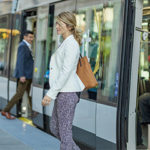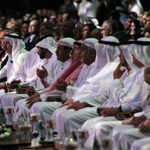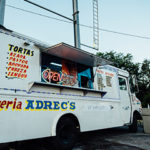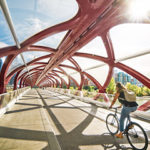
The Light City Baltimore festival was already in the works this time last year, when the destination was making national headlines for all the wrong reasons. But still, organizers drew a clear line from the April 2015 death of Baltimore resident Freddie Gray in police custody — resulting in protests, civil unrest, and, eventually, the indictment of six Baltimore police officers — to the first-ever program, held this past March 28–April 3.
Quite unexpectedly, the festival also helped illuminate a darkness that has shrouded Baltimore.
“I am neither an art nor a festival person,” said Jamie McDonald, co-chair of the Light City Baltimore Steering Committee, speaking at the Sustainability Innovation Conference, one of four Light City U conferences on innovation. “But when I looked at what festivals can mean for a city, like South by Southwest in Austin and Art Basel in Miami — they can be a catalyst for communities coming together for a common purpose.”
Approaching the one-year anniversary of Gray’s death, “We have an opportunity to use this festival to celebrate our oneness as a community,” McDonald said. “We believe that Baltimore can be the social-change capital of the world.”
Visit Baltimore, a founding partner of Light City, hosted its customer advisory board during the festival — and invited Convene as well. I arrived by train from Washington, D.C., on March 31, checked in to my host hotel, the Baltimore Marriott Waterfront, and headed to the University of Maryland, Baltimore County’s Columbus Center, right on the Inner Harbor, for day two of the Sustainability Innovation Conference, which was combined with Light City U’s Health Innovation Conference. “Today,” said Kim Horn, president of the Kaiser Foundation Health Plan of the Mid-Atlantic States, another founding partner, “we get to connect the dots between health and the environment.”
Two other Light City U conferences explored social innovation and creative innovation. “We’re bringing together innovators, thought leaders, and change-makers across four key industries to explore one question,” according to Light City’s website. “How do we become a more responsible and equitable society?”
Stimulating and inspiring as the Sustainability Innovation Conference was, I was more than ready that evening when Visit Baltimore hosted a boat cruise to take in the incandescent spectacle of Light City’s 28 visual art installations — sculptures, exhibits, and conceptual pieces, all of them using light in some way. Above and below decks on the yacht Raven, our group enjoyed drinks and food as we lazed our way through the Inner Harbor and into the Patapsco River. The dazzling spectacle of Light City gave way to the orange neon blaze of Baltimore’s iconic Domino Sugars sign, the cool sheen of Under Armour’s global headquarters, and the verdant glow of Fort McHenry National Monument and Historic Shrine, all perched at the water’s edge.
After the cruise, I took my time walking back to the Marriott. Light City Baltimore looked to be an unqualified success. Scores of people crowded the Inner Harbor on a cool, drizzly Thursday evening, lured by an indescribable riot of color and sound. Just steps off the pier where the Raven was tied up, I stopped to listen to DJ QuickSilva, irradiating the stage at Club Light City, which offered live music every night of the festival.
From there, I hopscotched from one pool of light to the next, taking full advantage of the notes accompanying each artwork. Some of my favorites: Glacier, a ghostly construct of steel and Plexiglas “creating the illusion of a melting glacier suspended in air”; Plaza, a garish assortment of funhouse structures “reminiscent of a psychedelic playground”; Pixel Promenade, stretched over a pedestrian bridge, “projecting words sent to the installation by festival-goers via Twitter”; Peacock, a fantastical, 20-foot assemblage piped with bright plumes of LED fiber optic; Lightwave: Baltimore’s Beacon, which projected visual representations of surrounding noise onto a panoramic screen around historic Seven Foot Knoll Lighthouse; and Voyage, a fleet of 300 paper boats that “uses the water as a canvas to create an organic matrix of ever-changing colored lights.”
My room on the 19th floor of the Marriott overlooked the Inner Harbor. I stood at the window for a long time after I got back, trying to take in as much as I could. Light City was battling the shadows, and winning. Mission accomplished.





